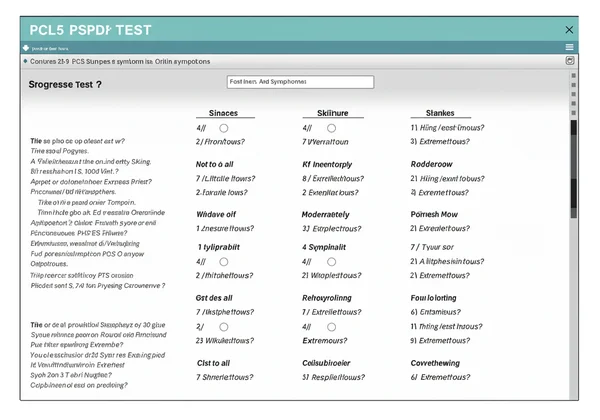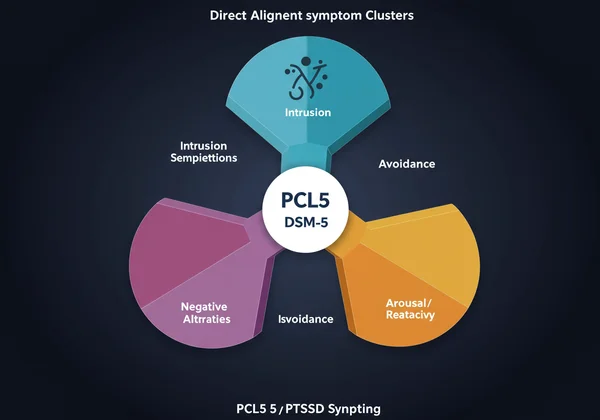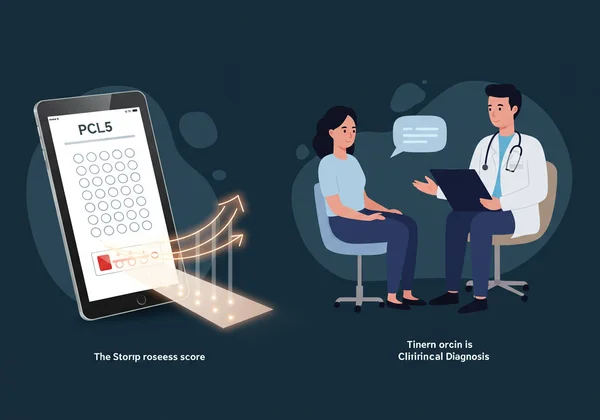PCL5 PTSD Symptom Test
After a traumatic event, you might find yourself navigating a complex emotional landscape, wondering if your experiences align with recognized conditions. One common question is, "What is PCL5?" This PCL5 (PTSD Checklist for DSM-5) is a crucial tool designed to help you understand symptoms related to Post-Traumatic Stress Disorder. It's often a vital first step towards gaining clarity. If you're seeking to learn more or explore your own experiences, our platform offers a confidential and insightful way to start. You can start your assessment today and begin to understand your unique journey.
What is the PCL5 and Its Core Purpose?
The PCL5 is a fundamental tool for assessing Post-Traumatic Stress Disorder symptoms. Its core purpose is to provide a reliable, standardized method for individuals and professionals to evaluate the presence and severity of PTSD symptoms. This assessment helps in identifying whether your experiences align with the criteria outlined in the Diagnostic and Statistical Manual of Mental Disorders, Fifth Edition (DSM-5).

The PCL5: A Trusted PTSD Screening Tool
As a trusted PTSD screening tool, this checklist is widely recognized and utilized across various settings, from clinical practices to research studies. It comprises a list of 20 symptoms, each directly corresponding to a specific diagnostic criterion for PTSD in the DSM-5. Users rate how much they have been bothered by each symptom over the past month, providing a quantitative measure of symptom severity. This allows for an objective look at your emotional well-being and helps flag potential areas for concern. The ease of access to an online PCL5 test on our platform makes initial self-reflection more convenient and private.
Who Can Benefit from Taking the PCL5?
The utility of this assessment extends to various individuals and groups. Primarily, it benefits general public/self-assessors who may have experienced a traumatic event and are questioning if their subsequent struggles indicate PTSD symptoms. For these individuals, this tool offers a private, accessible way to gain preliminary insight. Mental health professionals (clinical psychologists, psychiatrists, counselors) frequently use the PCL5 as a standardized PTSD Checklist to track symptom changes over time, aiding in treatment planning and progress monitoring. Furthermore, academic researchers and students rely on the checklist for its psychometric properties and consistency in studies related to trauma and mental health. Our platform ensures that all these user personas can conveniently access and utilize this valuable resource.
PCL5 & DSM-5: The Standard for PTSD Symptom Assessment
The strength and reliability of the PCL5 largely stem from its direct alignment with the DSM-5, the authoritative guide for diagnosing mental disorders. This strict adherence ensures that the assessment measures symptoms in a way that is consistent with current clinical understanding and diagnostic standards, making it a highly credible instrument for PTSD symptom assessment.
How the PCL5 Aligns with DSM-5 Criteria
The PCL5 is carefully designed to reflect the four distinct symptom clusters of PTSD as defined by the DSM-5. These clusters are:
- Intrusion: Unwanted, upsetting memories, flashbacks, or nightmares related to the trauma.
- Avoidance: Efforts to avoid thoughts, feelings, or external reminders associated with the trauma.
- Negative Alterations in Cognitions and Mood: Persistent negative beliefs, distorted thoughts, or emotional numbing following the trauma.
- Arousal and Reactivity: Irritability, reckless behavior, hypervigilance, difficulty concentrating, or sleep disturbance.
Each of the 20 questions on the PCL5 for DSM5 directly assesses one of these criteria, ensuring a comprehensive evaluation. This careful design strengthens its scientific foundation.

The 20 Questions: What Each Symptom Cluster Covers
Understanding the 20 symptoms of PTSD covered by this assessment can provide valuable insight even before taking the test. For instance, questions related to re-experiencing might ask about intrusive thoughts or nightmares. Avoidance questions might touch on efforts to steer clear of people or places that remind you of the trauma. Questions about negative changes in thinking and mood could explore feelings of detachment or persistent negative self-beliefs. Finally, arousal and reactivity questions might delve into issues like irritability, sleep disturbances, or being easily startled. These questions, while simple to answer, collectively paint a detailed picture of potential trauma symptoms, allowing for an immediate PCL5 score upon completion of the test.
Beyond the Test: What the PCL5 Can and Cannot Do
It's crucial to understand the scope and limitations of the PCL5. While it's an incredibly useful instrument, it serves a specific purpose in the broader context of mental health evaluation. Knowing its boundaries enhances trustworthiness and helps you seek appropriate next steps.
The Role of PCL5 in Self-Assessment and Professional Use
For those exploring their own mental health, this assessment offers a confidential gateway to self-understanding. It empowers individuals to gain an initial PCL5 assessment of their symptom severity, providing a structured way to articulate what they are experiencing. This can be a vital first step in deciding whether to seek professional help. In a clinical context, professionals use this tool to screen for potential PTSD, monitor treatment effectiveness, and track symptom changes over time. Its standardized nature allows for consistent data collection and aids in the therapeutic process, guiding discussions and interventions. The tool's versatility makes it valuable for both personal insight and clinical application.
Why the PCL5 is a Starting Point, Not a Diagnosis
It's vital to remember that while this checklist is an incredibly helpful screening tool, it isn't a diagnostic instrument. While your PCL5 score provides valuable insight into the severity of your symptoms and can indicate whether they align with PTSD criteria, Can the PCL5 diagnose PTSD? No, it cannot. Only a qualified mental health professional can provide an official diagnosis of PTSD following a comprehensive clinical evaluation. This assessment serves as an excellent starting point, prompting further exploration and, if necessary, professional consultation. This website explicitly states this limitation, ensuring users are well-informed and encouraged to pursue professional guidance when needed.

Empowering Your Journey with PCL5 Understanding
The PCL5 isn't just a series of questions; it’s a vital resource for anyone seeking to understand their experiences in the aftermath of trauma. By providing a structured, scientifically-backed approach to symptom assessment, it offers a clear pathway to self-awareness. Whether you're exploring your own symptoms, a professional seeking a reliable tool, or a researcher needing standardized data, this assessment offers significant support.
Our platform is dedicated to providing an accessible, confidential, and user-friendly experience for the PCL5 online test. Beyond offering an instant PCL5 score, our unique AI-driven reports provide deeper, personalized insights and actionable advice, taking your understanding to the next level. This comprehensive approach is designed to empower you on your journey towards mental well-being.
Take control of your understanding today. Explore our site to discover your results and gain the insights you need to take informed next steps.
Common Questions About the PCL5 Test
Here are some common questions we hear about the PCL5 test that might help clarify things:
Can the PCL5 Diagnose PTSD?
No, this assessment is a screening tool, not a diagnostic instrument. It helps identify the presence and severity of PTSD-related symptoms, providing an initial indication. A formal diagnosis of PTSD can only be made by a qualified mental health professional following a comprehensive clinical assessment. The results from your PCL5 test should always be discussed with a professional for proper interpretation and guidance.
What Age is the PCL5 For?
The PCL5 is primarily designed for use with adults (aged 18 and older) who have experienced a traumatic event. While there are other trauma-screening tools available for children and adolescents, this measure specifically aligns with adult DSM-5 criteria.
How is the PCL5 Different from Other Trauma Tests?
The PCL5 is unique in its direct and explicit alignment with the current DSM-5 diagnostic criteria for PTSD, making it a highly standardized and widely accepted measure. Unlike some other trauma tests that might be broader in scope or less integrated with specific diagnostic manuals, this tool focuses specifically on the 20 symptoms outlined in the DSM-5 for PTSD. Its structure and scoring are tailored to provide a direct reflection of these specific symptom clusters.
What is Considered a High PCL5 Score?
A higher PCL5 score generally indicates a greater severity of PTSD symptoms. While there isn't a single universal cutoff for a "high" score that definitively diagnoses PTSD (remember, it's a screening tool!), clinical guidelines often suggest scores above certain thresholds (for instance, 33-38 points, depending on the specific context) may mean further clinical evaluation for PTSD is warranted. What's most important is that your score is interpreted in context. You can gain a deeper understanding of your personal results by reviewing the detailed insights available on our site, and always by consulting with a mental health professional. To interpret your PCL5 score with greater understanding, visit our site.